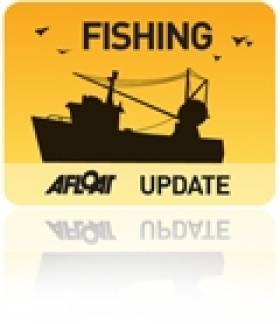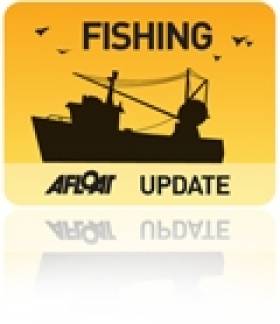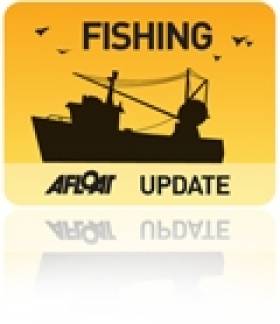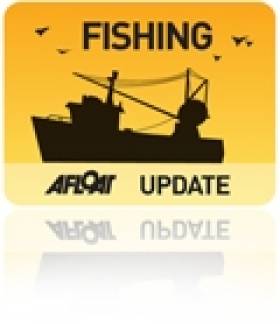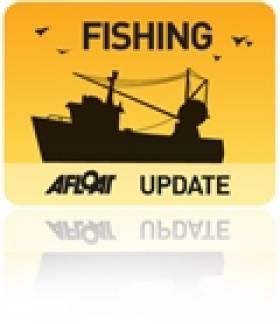Displaying items by tag: BIM
Irish Fisheries Chief Wants To Create A Taboo About Lifejackets
Tara McCarthy has a magnificent view out of her office windows.
“You could look out there all day,” she says as we chat in the office on Crofton Road in Dun Laoghaire, looking out on Dublin Bay. Even on a damp January afternoon it is a great vista as a ship heads out of Dublin Port into what it seems will be a harsh enough time ahead at sea. However, it is not the view we have met to discuss, but whether a taboo can be created around a troubling issue – safety at sea and those who will not wear lifejackets.
Tara McCarthy is Chief Executive of Bord Iascaigh Mhara, the State fisheries board, which has launched a campaign to persuade fishermen that they must wear lifejackets. There has been an attitude amongst them that it was better not to wear one. If a fisherman fell into the sea from the boat, it was likely that the sea would take him, so it was better not to struggle to live.
That was the attitude, about which a taboo would be in place if Tara McCarthy has her way.
The statistics are frightening. Fishing is thirteen times more dangerous than the construction industry. Over the last ten years 53 fishermen have lost their lives at sea. BIM research showed that quite a number of fishermen knew colleagues who died at sea but many of those fishermen, even though they knew a colleague who had died in a tragedy, would still not wear a lifejacket.
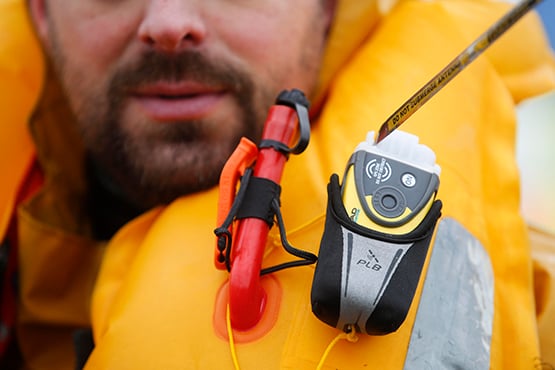
The new BIM lifejacket with built-in position finder
That shocked me and so it did the CEO also, which is why the lifejackets campaign is tough, hard-hitting.
“Those fishermen should realise the impact they could have on their families by a decision not to wear a lifejacket. It is, perhaps, shocking to face them with that realisation but we have launched a campaign that is deliberately hard-hitting campaign. “It is not soft, just saying that it would be nice to wear a lifejacket. We are facing fishermen with a life-impacting decision. We talked to fishermen about this and they told us to make it hard-hitting and that is what we are doing.”
• Listen to the BIM CEO on the programme above
Galway Bay Fish Farm Plans Withdrawn
#FishFarm - Bord Iascaigh Mhara (BIM) has withdrawn the application for its controversial fish farm proposal for the Aran Islands ahead of new plans to limit the size of aquaculture projects.
As the Irish Examiner reports, campaigners against the ambitious 500-hectare, 15,000 tonne organic salmon farm for Galway Bay have welcomed the decision by BIM to rethink its development in line with a new national strategic plan that will limit fish farms to under 7,000 tonnes.
BIM's application has been with the Department of the Marine for more than three years, with Marine Minister Simon Coveney saying this past March that he would not be drawn on any timeframe for a decision to approve what would have been the largest such fish farm in Europe.
The application has long faced opposition from local angling and environmental groups, as well as concerns from the EU over its environmental impact.
This past summer controversy arose again as campaigners blasted BIM for spending thousands of euro on PR on the project, that would have seen Ireland attempt to overtake Scotland as a leading producer of organic salmon.
The Irish Examiner has more on the story HERE.
Dubliner is Young Fishmonger of the Year
A Dublin Fishmonger with three retail outlets has been declared Ireland’s Young Fishmonger of the Year. George Stephens of The Fish Market in Blanchardstown was declared the winner at the final held in Kinsale last night. He told Tom MacSweeney why he liked being a fishmonger in an interview above.
Stephens also has retail outlets in Maynooth, Co.Kildare and in Mullingar Town. A professional chef with eight years’ seafood retail experience, he works with his wife and business partner Anne, developing new ready-to-go seafood products and has recently launched a new range of freshly fried fish in his Blanchardstown store.
The competition, run by Bord Iascaigh Mhara, was extensively judged over the past two months by a team of judges assembled by the board. This included practical skills and business testing.
This is the third year of the competition and the award was presented at television personality Martin Shanahan’s restaurant, Fishy Fishy, in Kinsale.
Tara McCarthy, Chief Executive of BIM, said the competition is intended to encourage young people to seek careers in the seafood industry.
George Stephens received a specially designed trophy, a study trip to France and a cheque for €1,000
An Bord Iascaigh Mhara (BIM) Seek New Chief Executive
#fishing – BIM, the Irish Sea Fisheries Board, are seeking a person with a record of success as a leader, preferably in the marine sector, to become its Chief Executive. The post is advertised in this morning's Irish Times newspaper. The post is based at BIM's Head Office in Dun Laoghaire. A copy of the advert is downloadable below as a jpeg file.
BIM Seeks Members for Regional Inshore Fisheries Forums
#inshorefisheries – Following the launch of the National Inshore Fisheries Forum (NIFF) earlier this year by the Minister for Agriculture, Food and Marine, Mr. Simon Coveney T.D. and the recent agreement on the terms of reference for the forum; BIM are now seeking members to take part in the Regional Inshore Fisheries Forums (RIFFs). Each RIFF will feed into the National Inshore Fisheries Forum and will link with the existing infrastructure of the Fisheries Local Action Groups or FLAG's programme. There are six FLAG's established in coastal regions around Ireland.
The RIFFs will comprise of no more than 12 members.
A minimum of 8 members will represent the inshore fisheries sector and will be appointed on the basis of:
their ability to represent the views of the inshore sector
their knowledge of inshore fisheries, fish stocks, and fishing methods, and
their capacity to engage on fisheries management issues.
In addition, the FLAG will aim to ensure that the membership is representative of the FLAG region's geographical coverage and the characteristics of the region's inshore fleet and fisheries. Applicants must demonstrate support within their respective sector for their nomination to a forum. The balance of the membership will include stakeholders from marine sectors other than fisheries, such as seafood processing/sales, marine leisure, marine tourism, environmental NGOs and community organisations.
Should the FLAGs consider a sector or area is lacking in representation the FLAG reserves the right to approach appropriate individuals or organisations to seek members.
If you are interested in applying for membership of the RIFFs, please e-mail Caroline Curraoin in BIM [email protected] or send your application by post to FLAG Co-ordinator, BIM, , P.O. Box 12, Crofton Rd., Dun Laoghaire , Co. Dublin. Full details on the terms of reference for the National Inshore Fisheries Forum are available on www.bim.ie
The closing date for all applications is Friday, 29th August 2014.
#Seafood - Just days after his resignation as CEO of Bord Iascaigh Mhara (BIM), Jason Whooley has been announced as the chief executive of Bio-marine Ingredients Ireland, as OceanFM reports.
The new body, a joint venture between the Killybegs Fishermen’s Organisation and Norwegian firm Biomarine Science Technology, is behind the "game-changer" €35 million project in the Donegal fishery harbour that's expected to create 50 construction jobs and a further 70 direct and indirect positions once operational.
As previously reported on Afloat.ie, the new scheme - promoted by the development of the new boarfish fishery - is set to be the largest marine food ingredients plants in the world when it enters its first full year of production in 2017.
#FishFarm - Bord Iascaigh Mhara (BIM) has responded to concerns from environmental groups that an ingredient in treatments for sea lice in salmon farms poses a threat to wild marine life.
As Galway Bay FM reports, campaigners Galway Bay Against Salmon Cages - one of the groups opposed to the planned Galway Bay fish farm - say that cypermethrin, an active ingredient in veterinary medicine used to treat sea lice, is toxic to aquatic organisms.
BIM aquaculture manager Donal Maguire attempted to play down fears over the use of the pesticide, saying it has been fully tested for toxicology in the marine environment.
However, another campaign group claims BIM's position is contrary to the manufacturer's own warnings on the use of the drug.
According to FishNews.eu, Friends of the Irish Environment (FIE) cited the Irish Medicines Board's product description for cypermethrin, which states that it is "dangerous to fish and other aquatic life" and demands that the chemical "should not be allowed to contaminate water".
FIE went on to describe cypermethrin as "a biocide which kills life, not a medicine that saves lives" and as "a highly active neurotoxin" with "known effects on fish and, most sensitive of all, crustaceans such as crabs and lobsters. Bathers and watersports [enthusiasts] may also be at risk."
Earlier this month, Inland Fisheries Ireland (IFI) expressed "serious concerns" over the findings of a study on wild salmon in Ireland that claimed fish farm schemes were less harmful to wild fish than pollution and possibly even beneficial to wild catchments.
IFI is among the significant opposition to BIM's proposed organic salmon farm off the Aran Islands, a 500-hectare project that would be the largest of its kind in Europe and create hundreds of jobs in the locality.
#Fishing - The Irish Times reports that Inland Fisheries Ireland (IFI) has expressed "serious concerns" over the findings of a new study on wild salmon in Ireland.
The State agency for Ireland's fisheries argues that the study - which concluded not only that pollution has a greater impact on wild salmon numbers than fish farming, but also that salmon catchments in close proximity to aquaculture schemes were some of the best performing - is based on flawed methodology.
IFI is among the chorus of voices opposed to the planned organic salmon farm off the Aran Islands in Galway Bay - a 500-hectare project by Bord Iascaigh Mhara (BIM) that would be the largest of its kind in Europe if given the go-ahead.
Marine Minister Simon Coveney recently attempted to alleviate concerns over the controversial scheme, claiming there would be no damage to the environment or fish stocks.
However, the controversy doesn't end there, as last month celebrity chef and 'Slow Food' champion Darina Allen wrote to the minister over erroneous claims in BIM's environmental impact statement (EIS) for the project.
As reported by the Galway Independent, Allen contacted Minister Coveney to clarify that the Slow Food movement does not support fish farming projects, after references to the initiative in the EIS "seemed to create a lot of confusion".
Allen told the paper: “Many people contacted me under the perception that Slow Food endorsed the whole salmon farm thing and actually Slow Food has made no statement whatsoever on it.”
Later, Michèle Mesmain of Slow Food International confirmed that “salmon farming does not fit in any pillar of Slow Food”.
The Galway Independent has much more on the story HERE.
#FishFarm - The Galway Bay fish farm debate rolls on as Ireland's Marine Minister says there will be no damage to the environment or wild fish stocks.
Simon Coveney was speaking to Galway Bay FM last week on Bord Iascaigh Mhara's (BIM) proposals for a deep sea salmon farm off the Aran Islands.
The 500-hectare scheme would be the largest of its kind in Europe and has the potential to create hundreds of jobs in the region. A decision on BIM's licence application for the development is set to be made in the coming months.
But the plans have been opposed by conservationists, local anglers and the even the State fisheries body.
Last Wednesday 22 May, Inland Fisheries Ireland (IFI) published an FAQ on its concerns regarding the Galway Bay fish farm proposal, its own submission regarding the environmental impact statements attached to the licence application, and its reasons for avoiding a public debate on the issue.
"IFI is satisfied that its submission, which is supported by international scientific studies, clearly sets out its concerns and recommended measures for mitigation," it says.
Groups Appeal For Clarity Over Galway Bay Fish Farm Plans
#FishFarm - Groups opposed to the controversial deep-sea fish farm in Galway Bay have written to TDs asking them to bring clarity to the growing conflict over the proposals.
As the Southern Star reports, the groups have asked for a review of the current licensing requirements for aquaculture schemes to ensure that the process is transparent and open to independent review - amid news that both local TDs and State agencies are squabbling over the issue.
"To have a single minister responsible for all these stages of an industry that has such serious pollution issues associated with it, as well as the potential to devastate valuable salmon and sea trout stocks, is inappropriate and open to abuse," argues Alec O'Donovan of Save Bantry Bay, one of the groups in an alliance that include local tourism, angling and environmental interests.
Group chairman Kieran O'Shea singled out for criticism the Department of the Marine's apparent determination to push forward with Bord Iascaigh Mhara's (BIM) fish farm plans in spite of a moratorium on further development of salmon farming three years ago at EU level.
"This not only makes a mockery of EU law but highlights a worrying lack of concern for the environment," said O'Shea.
Meanwhile, another opposition group has spoken out over a letter of support for the fish farm plans by Irish seafood producers and other businesses.
According to the Galway Independent, Brian Curran Galway Bay Against Salmon Cages (GBASC) claimed the letter - signed by 43 firms, only six of which are directly involved in food production in Galway - was a "set-up".
A spokesperson for BIM dismissed Curran's comments as being "in very poor taste" in seeking "to undermine the intentions or credibility of anyone who would go out of their way to place their support for the proposal 'on the record'."
As previously reported on Afloat.ie, the 500-hectare development off Inis Óirr in the Aran Islands would be the largest of its kind in Europe.


























